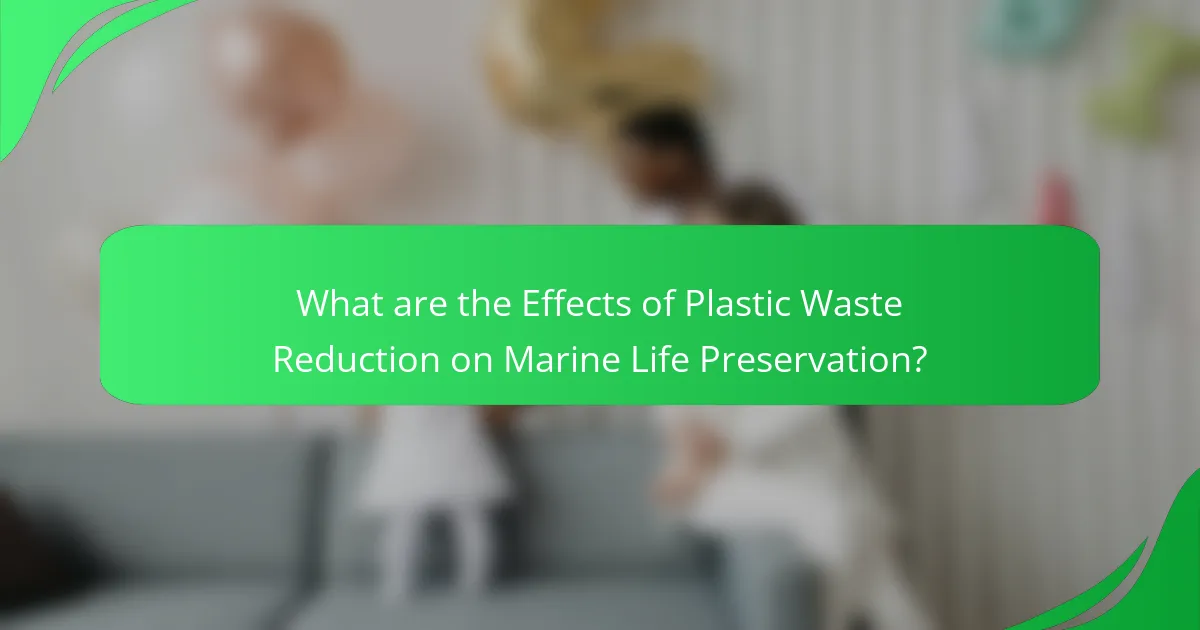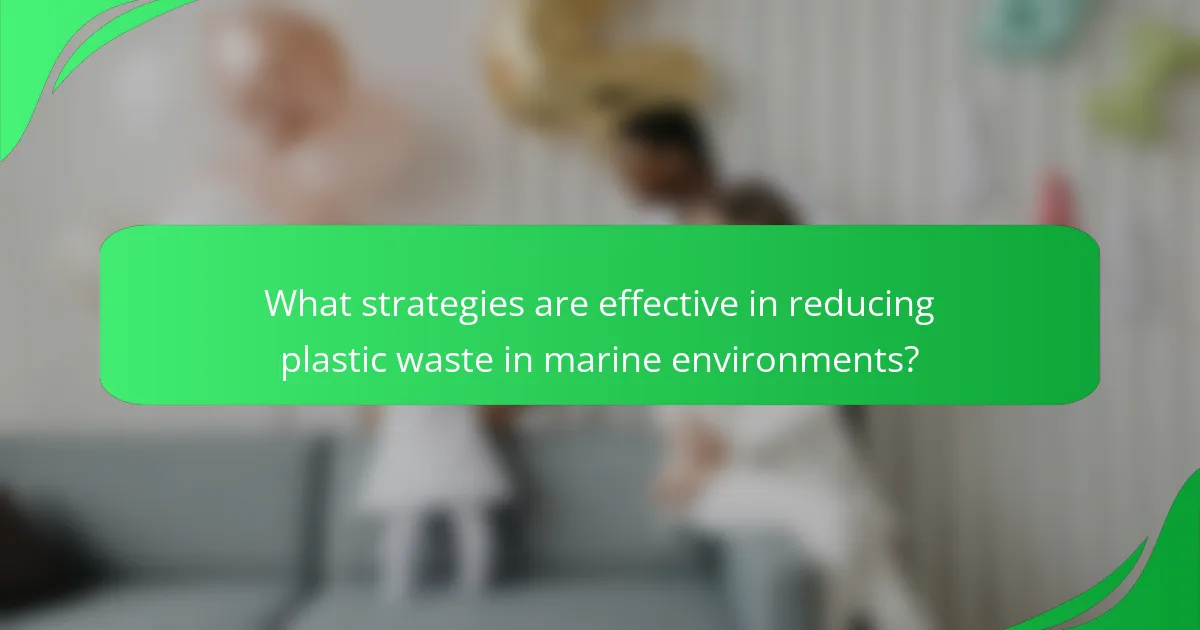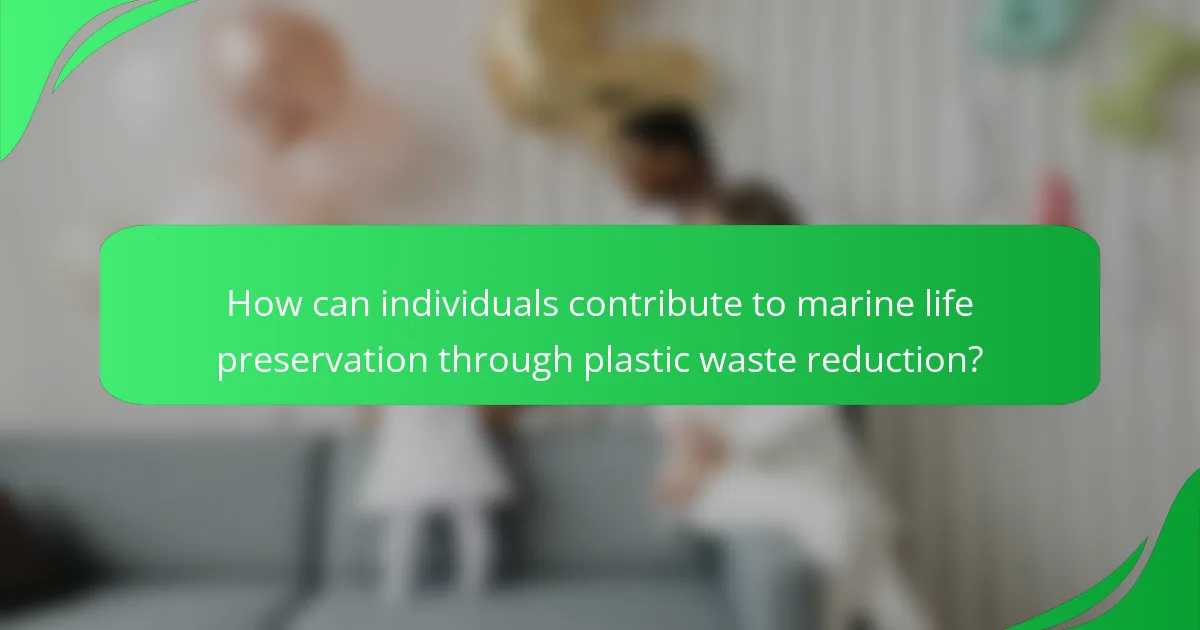Plastic waste reduction is crucial for the preservation of marine life, as it significantly decreases ocean debris and minimizes entanglements and ingestion of harmful microplastics by marine animals. Over 100,000 marine mammals die annually due to plastic pollution, highlighting the urgent need for effective waste management strategies. Implementing stricter regulations on plastic production, promoting recycling programs, and supporting biodegradable alternatives are essential steps in mitigating this issue. Additionally, community engagement through clean-up efforts and public education can enhance awareness and foster stewardship for healthier marine ecosystems. Collectively, these actions contribute to the sustainability of marine environments and the overall health of the planet.

What are the Effects of Plastic Waste Reduction on Marine Life Preservation?
Reducing plastic waste significantly benefits marine life preservation. It decreases the amount of debris in oceans, leading to fewer entanglements for marine animals. Studies show that over 100,000 marine mammals die each year due to plastic pollution. Less plastic in the water reduces the ingestion of microplastics by fish and other sea creatures. This ingestion can cause health issues, including reproductive harm and death. Furthermore, cleaner oceans promote healthier ecosystems, supporting biodiversity. Healthy marine ecosystems are crucial for the overall health of the planet. Effective waste reduction strategies can lead to a sustainable future for marine life.
How does plastic waste impact marine ecosystems?
Plastic waste significantly harms marine ecosystems. It leads to ingestion by marine animals, causing injury or death. For instance, studies indicate that over 800 species are affected by marine debris. Additionally, plastic debris disrupts habitats, such as coral reefs, by smothering them. Microplastics, which result from larger plastic breakdown, contaminate the food web. Research shows that these microplastics can accumulate in fish, posing risks to human health. Furthermore, plastic waste contributes to the spread of invasive species through floating debris. Overall, the presence of plastic waste in oceans severely disrupts the balance of marine ecosystems.
What specific threats do plastics pose to marine species?
Plastics pose several specific threats to marine species. Marine animals often ingest plastic debris, mistaking it for food. This ingestion can lead to internal injuries, malnutrition, and even death. Additionally, plastics can entangle marine species, restricting their movement and causing injury or drowning. Microplastics, which are small plastic particles, can accumulate in the bodies of marine organisms. This accumulation can disrupt hormones and reproductive systems in species like fish and shellfish. Furthermore, plastics can transport harmful chemicals and pollutants into marine ecosystems. These chemicals can bioaccumulate in the food chain, affecting larger predators, including humans. According to the United Nations, over 800 species worldwide are affected by marine debris, primarily plastics.
How does plastic pollution affect marine habitats?
Plastic pollution severely impacts marine habitats. It leads to the ingestion of plastic by marine organisms. This ingestion can cause physical harm, malnutrition, and even death. Marine animals often mistake plastic for food, which disrupts their feeding habits. Additionally, plastic debris can entangle marine life, leading to injuries or drowning.
Plastic pollution also contributes to habitat degradation. Coral reefs and seabeds can be smothered by plastic waste. This smothering reduces biodiversity and disrupts the ecosystem balance. Furthermore, toxic chemicals from plastics can leach into the water, harming marine organisms.
Studies indicate that over 800 species are affected by marine debris, including plastics. The United Nations Environment Programme highlights that plastic pollution is a significant threat to ocean health.
Why is reducing plastic waste crucial for marine life?
Reducing plastic waste is crucial for marine life because plastics cause significant harm to ocean ecosystems. Marine animals often ingest plastic debris, mistaking it for food. This ingestion can lead to malnutrition, internal injuries, and death. Additionally, plastics can entangle marine species, restricting their movement and causing injury or drowning. Microplastics, which break down from larger plastic items, contaminate the water and enter the food chain. Studies show that over 800 species are affected by marine debris, with many facing extinction risks. Reducing plastic waste helps protect biodiversity and ensures healthier ocean habitats.
What are the long-term benefits of plastic waste reduction for ocean health?
Plastic waste reduction significantly improves ocean health. It decreases marine pollution, benefiting aquatic ecosystems. Reduced plastic in oceans leads to healthier marine life. Sea creatures are less likely to ingest or become entangled in plastic debris. Healthy oceans support biodiversity and enhance fish populations. This, in turn, supports global food security. Studies show that cleaner oceans can restore habitats like coral reefs. Healthy coral reefs provide shelter for numerous marine species. Thus, plastic waste reduction fosters a more resilient ocean ecosystem.
How does plastic waste reduction contribute to biodiversity preservation?
Plastic waste reduction directly contributes to biodiversity preservation by minimizing habitat destruction and pollution. Reducing plastic waste decreases the likelihood of marine animals ingesting or becoming entangled in debris. Studies show that over 800 species are affected by marine debris, which can lead to population declines. Less plastic in the environment also means healthier ecosystems, as it reduces chemical leaching into water bodies. Healthy ecosystems support diverse species, enhancing overall biodiversity. Furthermore, cleaner habitats promote the survival of vulnerable species, helping maintain ecosystem balance.

What strategies are effective in reducing plastic waste in marine environments?
Effective strategies for reducing plastic waste in marine environments include implementing stricter regulations on plastic production and usage. Governments can enforce bans on single-use plastics, which significantly contribute to marine pollution. Promoting recycling programs increases the recovery of plastics, reducing the amount that reaches oceans. Public awareness campaigns educate communities about the impact of plastic waste on marine life.
Additionally, supporting the development of biodegradable alternatives can lessen reliance on traditional plastics. Engaging local communities in beach clean-up efforts fosters stewardship and reduces litter. Research indicates that regions with active waste management policies have lower levels of plastic debris in marine environments. For instance, a study published in “Science” by Jambeck et al. (2015) highlights the correlation between waste management practices and reduced ocean plastic pollution.
What are the most successful initiatives for plastic waste reduction?
Successful initiatives for plastic waste reduction include bans on single-use plastics, recycling programs, and public awareness campaigns. Many countries have implemented bans on plastic bags and straws. For example, California’s ban on plastic bags reduced plastic waste significantly. Recycling programs encourage proper disposal and processing of plastic materials. The European Union has set ambitious recycling targets, aiming for 50% of plastic waste to be recycled by 2025. Public awareness campaigns educate consumers about the impact of plastic waste. Initiatives like the Ocean Conservancy’s “International Coastal Cleanup” mobilize volunteers to remove plastic waste from beaches. These efforts collectively contribute to reducing plastic pollution and protecting marine life.
How do community-led programs contribute to plastic waste reduction?
Community-led programs significantly contribute to plastic waste reduction by promoting local engagement and awareness. These programs often involve community clean-up events, which directly remove plastic debris from the environment. Research shows that organized clean-ups can lead to the collection of thousands of pounds of plastic waste.
Additionally, educational initiatives within these programs raise awareness about the impact of plastic pollution. They inform community members about recycling practices and alternatives to single-use plastics. Studies indicate that communities with active educational programs see a measurable decrease in plastic consumption.
Furthermore, community-led programs often advocate for policy changes that support plastic waste reduction. They mobilize residents to participate in local governance and influence regulations on plastic use. Evidence from various cities demonstrates that such advocacy can lead to bans on plastic bags and straws.
In summary, community-led programs foster collective action, education, and advocacy, all of which are crucial for reducing plastic waste.
What role do governments play in enforcing plastic waste policies?
Governments play a crucial role in enforcing plastic waste policies. They establish regulations that limit plastic production and usage. Governments implement bans on single-use plastics to reduce waste. They also promote recycling initiatives through legislation. Additionally, governments impose fines for non-compliance with plastic waste regulations. For instance, the European Union has set directives to reduce plastic pollution. These directives require member states to adopt national measures. This structured approach helps to ensure accountability and compliance. By enforcing these policies, governments contribute significantly to marine life preservation.
What technologies are being developed to combat plastic pollution?
Innovative technologies are being developed to combat plastic pollution. Biodegradable plastics are one such solution. These materials break down more quickly than traditional plastics. Enzymatic recycling technologies are also emerging. They use enzymes to decompose plastics into their original monomers for reuse. Waste-to-energy conversion technologies are being implemented as well. They convert plastic waste into energy through incineration or gasification. Ocean cleanup technologies are gaining traction too. These include floating barriers designed to collect plastic waste from water bodies. Additionally, AI-powered waste sorting systems improve recycling efficiency. These advancements aim to significantly reduce plastic pollution and its impact on marine life.
How do biodegradable materials help in reducing plastic waste?
Biodegradable materials help in reducing plastic waste by breaking down naturally in the environment. Unlike conventional plastics, which can take hundreds of years to decompose, biodegradable materials typically decompose within months to a few years. This rapid degradation minimizes the accumulation of waste in landfills and oceans.
Research indicates that biodegradable materials can reduce the volume of plastic waste by up to 50% in certain applications. For example, a study published in the journal “Environmental Science & Technology” found that biodegradable plastics can significantly lessen marine debris. This reduction is crucial for preserving marine life, as plastic waste poses severe threats to aquatic ecosystems.
By replacing traditional plastics with biodegradable options, we can mitigate the harmful impacts of plastic pollution on marine habitats and species.
What innovations are being explored to clean up ocean plastics?
Innovations to clean up ocean plastics include advanced filtration systems, autonomous drones, and biodegradable materials. Advanced filtration systems can capture microplastics in water. Autonomous drones are being developed to locate and collect plastic debris. Biodegradable materials aim to reduce future plastic waste. Research shows that these technologies could significantly decrease ocean plastic levels. For instance, the Ocean Cleanup project has deployed systems that have already removed tons of plastic from the Great Pacific Garbage Patch. These innovations are essential for protecting marine ecosystems and preserving marine life.

How can individuals contribute to marine life preservation through plastic waste reduction?
Individuals can contribute to marine life preservation by reducing plastic waste. They can minimize single-use plastics by opting for reusable bags, bottles, and containers. This reduces the amount of plastic entering oceans. Studies show that over 8 million tons of plastic pollute marine environments annually. Individuals can also participate in local clean-up efforts to remove plastic from beaches and waterways. Encouraging recycling and proper waste disposal further decreases plastic pollution. In 2021, the Ocean Conservancy reported that community clean-ups significantly reduce marine debris. Educating others about the impacts of plastic waste can amplify these efforts. Each small action collectively leads to a healthier marine ecosystem.
What practical steps can individuals take to reduce plastic use?
Individuals can reduce plastic use by adopting several practical steps. First, they can switch to reusable bags for shopping. This practice significantly decreases single-use plastic bag consumption. Second, individuals should choose products with minimal packaging. Opting for bulk items reduces the amount of plastic waste generated. Third, using a reusable water bottle instead of buying bottled water is effective. This action can prevent millions of plastic bottles from entering landfills annually. Fourth, individuals can avoid plastic straws and utensils by using alternatives made from metal, bamboo, or compostable materials. This change can lead to a substantial reduction in plastic pollution. Additionally, they can support companies that prioritize sustainable packaging. This support encourages more businesses to adopt eco-friendly practices. Finally, participating in local clean-up events helps remove existing plastic waste from the environment. These steps collectively contribute to reducing plastic use and its detrimental effects on marine life.
How can consumers make informed choices to minimize plastic consumption?
Consumers can minimize plastic consumption by choosing reusable products. Reusable bags, bottles, and containers reduce the need for single-use plastics. They can also opt for products with minimal or no plastic packaging. Research shows that reducing plastic packaging can significantly decrease plastic waste. Additionally, consumers can support brands that prioritize sustainability. Purchasing from companies that use biodegradable materials helps reduce plastic pollution. Educating themselves about recycling practices further enhances their impact. Accurate recycling can prevent plastics from entering landfills and oceans. According to the Ellen MacArthur Foundation, improving recycling rates can cut plastic waste by 20%.
What are some effective recycling practices for everyday items?
Effective recycling practices for everyday items include sorting materials correctly. This means separating plastics, metals, paper, and glass. Many municipalities provide specific guidelines for recycling. For example, check local regulations to know which plastics are accepted. Rinse containers before recycling to prevent contamination. Flatten cardboard boxes to save space in recycling bins. Use designated recycling bins to avoid confusion with trash. Educate others about recycling practices to increase community participation. According to the EPA, recycling and composting prevented the release of 186 million metric tons of carbon dioxide equivalent into the air in 2018.
What are the benefits of participating in local clean-up efforts?
Participating in local clean-up efforts significantly benefits the environment and community. It helps reduce plastic waste, which is a major threat to marine life. Clean-up activities remove debris from beaches and waterways, preventing it from entering oceans. This action directly contributes to healthier marine ecosystems. Studies show that cleaner environments promote biodiversity. Additionally, community involvement fosters a sense of responsibility and awareness about environmental issues. Local clean-ups also encourage social connections among participants. Engaging in these efforts can lead to increased local pride and stewardship.
How do community clean-up events impact marine ecosystems?
Community clean-up events positively impact marine ecosystems by reducing plastic waste and debris. These events remove litter from beaches and coastal areas. Less plastic in the water decreases the risk of entanglement for marine animals. It also reduces ingestion of harmful materials by fish and other marine life. Studies show that cleaner environments support healthier ecosystems. For example, a clean beach can enhance local biodiversity. Additionally, community involvement raises awareness about marine conservation. Increased awareness can lead to more sustainable practices in local communities.
What resources are available for organizing local plastic waste reduction initiatives?
Local plastic waste reduction initiatives can utilize various resources. Community organizations often provide support and guidance. Local governments may offer funding and logistical assistance. Educational materials are available from environmental nonprofits. Online platforms can connect volunteers and resources. Workshops and training sessions help build skills for effective initiatives. Partnerships with local businesses can enhance outreach and impact. Social media serves as a tool for awareness and engagement. Research studies provide data that can support advocacy efforts.
The main entity of this article is the effects of plastic waste reduction on marine life preservation. The article outlines how reducing plastic waste benefits marine ecosystems by decreasing debris, which leads to fewer entanglements and ingestion of harmful materials by marine animals. It discusses the specific threats posed by plastics to marine species, the degradation of habitats, and the importance of effective waste reduction strategies. Additionally, the article highlights successful initiatives, community involvement, and the role of individuals and governments in combating plastic pollution to protect marine biodiversity and promote healthier ocean environments.